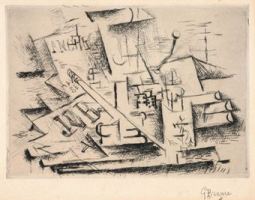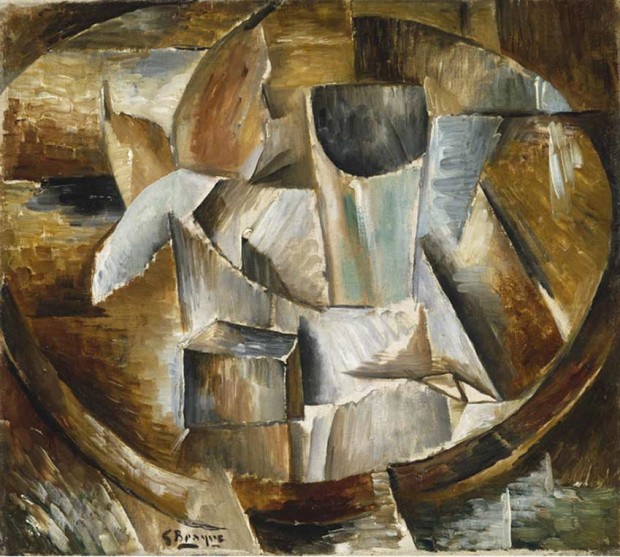
Georges Braque, Glass on a Table, 1909–10, oil on canvas. Tate, London. © 2011 Artists Rights Society (ARS), New York / ADAGP, Paris
There is a popular myth that Genius Is Born Of Suffering. The idea is so pervasive and pretentious it demands every word be capitalized when written. Yet the Kimbell Art Museum’s Picasso and Braque: The Cubist Experiment, 1910-1912 is a male-bonding ode to the specular good time had by Pablo Picasso and Georges Braque during the fecund period later named Analytic Cubism.
The first room contains Cubist prints. As the small etchings and drypoints contained in this initiate section of the exhibition seem like the work of one artist, discernment of Picasso’s work from Braque’s is particularly vexing and remains so in the next room, devoted to painting. Braque’s “Fox” and Picasso’s “Still Life with a Bottle of Marc” were made at the same time, could be two of a series, and stand as just one example of these two spirited souls in artistic simpatico.
The second room continues the guessing game of whose work is this?. Several paintings are framed as ovals, but both men play in that format and its shattered-glass fragmentation of imagery. Many pieces have a playful drinking theme full of bonhomie instead of tortured alcoholic demons. Elements of music turn up quite a lot. The comprehensive effect imbibes this venerated art museum with the romance and jollity of life in a Parisian café, 100 years ago.
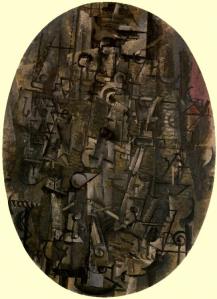
Georges Braque, Still Life with Bottle and Glasses, spring 1912, oil on canvas. Robert B. and Mercedes H. Eichholz Collection. Photo © MegaVision. © 2011 Artists Rights Society (ARS), New York / ADAGP, Paris
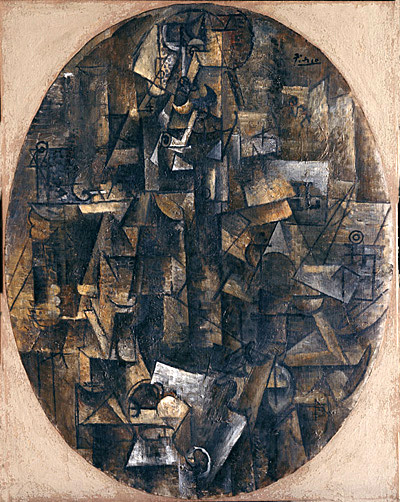
Pablo Picasso, Man with a Pipe, summer 1911, oil on canvas. Kimbell Art Museum. Photo © MegaVision. © 2011 Estate of Pablo Picasso / Artists Rights Society (ARS), New York
If there is one realm where Picasso takes command of the experiment and distinguishes himself from his friend, it is the Cubism-ization of persons, specifically but not surprisingly, the female nude. Though dark browns and bronzes dominate all of the paintings, black smoke-like currents surrounding the subject of one of Picasso’s nudes suggests a darkness of mind as well as palette, prompting one of his friends to say the artist “had gone mad.”

Pablo Picasso, Portrait of a Woman, 1910, oil on canvas. Museum of Fine Arts, Boston. © 2011 Estate of Pablo Picasso / Artists Rights Society (ARS), New York
The show mentions other art figures who influenced the Cubist Experiment, whether as role model or target for rebellion – Jewish writer Max Jacob, for whom Picasso illustrated the novel, “Saint Matorel,” Cezanne’s simplification of natural objects into pure shape, “Warrior Ancestor Figure,” a 19th century work of African art by the Hemba people, and a Luis Melendez still life illustrating the traditional perspective that Braque and Picasso were happily aiming to corrupt.
There is a third room explicating technique and materials, including a state-of-the-art technological exploration of Picasso’s “Man with a Pipe.” The artists called their collaborative lifestyle/workstyle “laboratory research” during these years, and in that spirit, the Kimbell and its collaborator, the Santa Barbara Museum of Art, push art’s current boundaries with an iPad app that enable visitors to interact with the exhibitions and subsequently, the artists themselves. The power of collaboration strikes again.
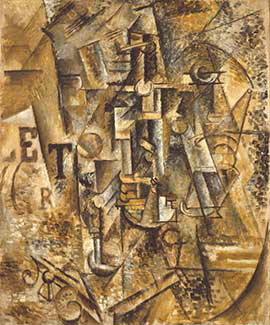
Pablo Picasso, Still Life with a Bottle of Rum, summer 1911, oil on canvas. The Metropolitan Museum of Art, New York. Jacques and Natasha Gelman Collection, 1998. © 2011 Estate of Pablo Picasso / Artists Rights Society (ARS), New York
Picasso and Braque: The Cubist Experiment, 1910-1912 was conceived and organized by Eik Kahng, chief curator of the Santa Barbara Museum of Art, in partnership with Malcolm Warner, deputy director of the Kimbell Art Musuem.
It runs through August 21, 2011, in Fort Worth.
Betsy Lewis is a writer who lives in Dallas and collaborates with two demanding dogs who won’t share their liquor.


